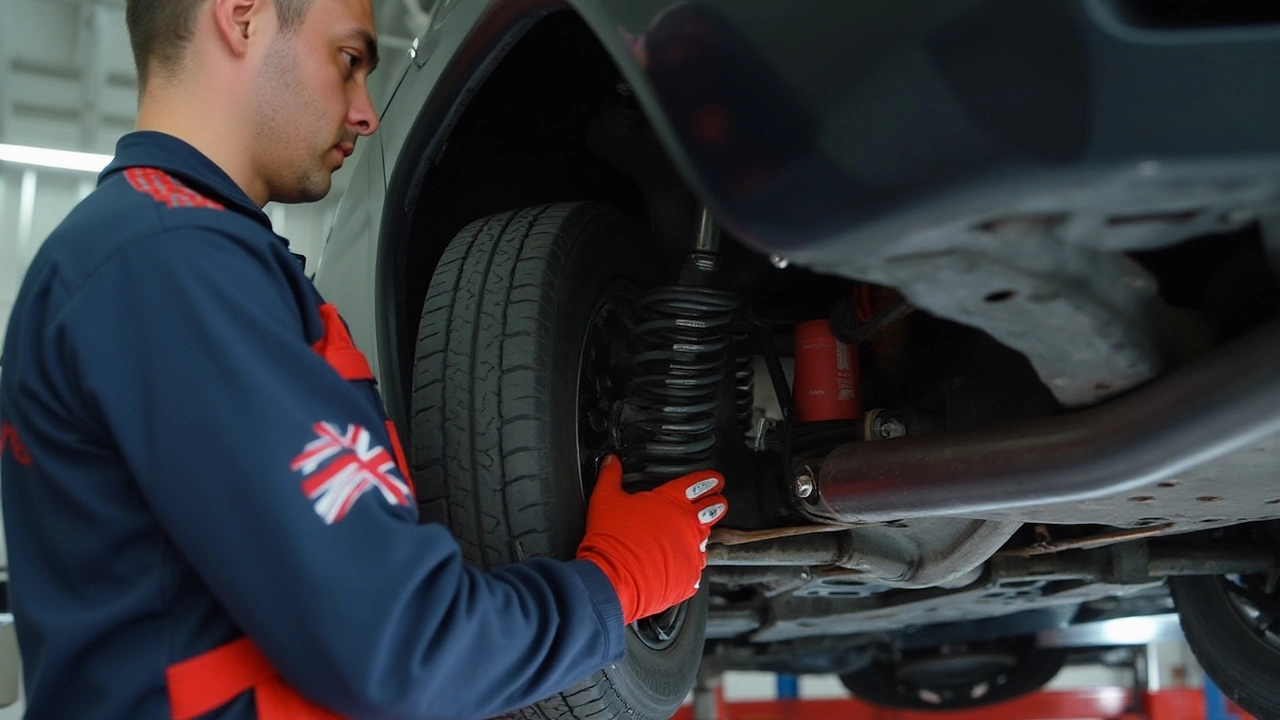When it comes to enhancing your vehicle's performance and appearance, suspension choices play a pivotal role. Many car enthusiasts often find themselves wondering which setup can achieve the smoothest ride without sacrificing the dynamic appeal of their vehicle. The world of suspensions is vast, offering an array of options ranging from lowering springs to more complex arrangements.
Understanding the fundamentals of vehicle suspension can bring clarity as you navigate through choices to improve your driving experience. From the improved handling of lowering springs to the luxury-like glide of advanced systems, options tailored to each driver's need are available. This exploration into suspension systems aims to simplify the decision-making process, providing you with insights to find that perfect harmony between comfort and performance.
- Understanding Vehicle Suspension Systems
- Benefits of Lowering Springs
- Factors Affecting Ride Quality
- Comparing Popular Suspension Systems
- Tips for Choosing the Right Setup
- Maintenance and Longevity
Understanding Vehicle Suspension Systems
The way your car feels on the road is largely influenced by its suspension system, which acts as the vehicle's secret weapon for balancing comfort, handling, and road contact. At its core, a vehicle suspension system is an intricate assembly of springs, shock absorbers, and linkages that connect a vehicle to its wheels. It manages the forces generated during driving, providing a buffer for passengers against the bumps and undulations of the road. The suspension ensures the tires maintain an effective grip, delivering a smooth and controlled ride. It is an essential component for both performance and safety.
One of the oldest and simplest types of suspension systems is the leaf spring suspension. Leaf springs are long bundles of steel layered together, originally created on horse-drawn carriages. Despite their age, they are still widely used in modern trucks and vans due to their ruggedness and load-carrying capability. Coil springs, on the other hand, are another common type of spring system. These are essentially heavy-duty torsion bars that compress and expand to absorb shock. When combined with a damper or shock absorber, they give an enviable mix of softness and stability, making them a favorite for smoother rides.
Many modern vehicles now adopt a more sophisticated independent suspension system. Unlike the solid axle systems of yesteryears, where both wheels move together, independent systems allow each wheel to react individually to bumps, providing better ride comfort and handling. Double-wishbone and multi-link suspensions fall into this category, known for their precision in tuning vehicle dynamics. The Mercedes-Benz E-Class, for instance, uses a sophisticated version of the multi-link suspension that showcases the beauty of independent systems in luxury cars. It's fascinating how manufacturers continue to adapt these systems, each year bringing innovations aimed at isolating passengers from the road.
Some modern advancements in vehicle suspension include adaptive and air suspension systems. Adaptive suspension systems use sensors and microprocessors to adjust the dampening forces according to driving conditions dynamically. This advancement has vastly improved ride comfort without compromising handling. Air suspension replaces traditional springs with airbags that inflate and deflate to vary the ride height and stiffness. The versatility it provides, from rock-solid handling to cloud-like smoothness, makes it highly appealing. Audi's A8, boasting this system, offers its occupants a ride that adjusts seamlessly to varying terrains and speeds. It’s like gliding on a cushion of air.
"The ideal suspension system is perhaps one that is infinitely soft yet completely stable," notes Car and Driver magazine. It's this delicate balancing act that engineers and enthusiasts strive for in perfecting vehicle suspension systems.
Each suspension type comes with its advantages and trade-offs, and selecting the right one is a matter of meeting specific needs, ranging from load handling to comfort prioritization. This understanding is essential whether you’re choosing to upgrade your car for enhanced performance or to get the absolute best in ride comfort. As technology progresses, the line between comfort and performance continues to blur, giving drivers more choices than ever before.
Benefits of Lowering Springs
Lowering springs are often the go-to modification for drivers who want to enhance the look and feel of their vehicles. They offer a straightforward way to improve aerodynamics and road handling, which is why they are a popular choice among car enthusiasts. By reducing the ride height, lowering springs lower the center of gravity of the vehicle. This change alone can have a significant impact on the way the car corners. With a lower center of gravity, your vehicle feels more planted on the road, reducing body roll during aggressive turns. Suspension systems equipped with lowering springs often deliver a crisper, more responsive driving experience. This enhancement translates into a sportier feel that many drivers crave.
Aside from improving handling, lowering springs can also enhance the aesthetics of your car. The reduced gap between the tires and the wheel arches gives any vehicle a more aggressive and sleek stance. This visual transformation is appealing to many drivers who see their cars as more than just a means of transport but as an extension of their personality. A tighter stance not only boosts confidence in driving dynamics but also increases pride of ownership. Lowering springs can make a dramatic difference to the appearance, turning heads as you cruise down the street.
The advantages aren't just functional. When integrated into your vehicle's suspension, lowering springs contribute to better tire contact with the road surface. This improved alignment means more even wear on tire treads, potentially extending the lifespan of your tires. Drivers can benefit from this cost-efficient upgrade, balancing performance enhancements with long-term savings. Adding to this, better tire contact results in enhanced traction, which can be crucial during slippery conditions, offering an additional layer of safety beyond just looks and feel.
Sports Car expert and enthusiast, Matt Farah, once said, "Lowering a car isn’t just about looks. It’s about improving the physics of how a car moves." This sentiment rings true as lowering springs bridge the gap between style and functionality, providing an engaging driving experience.
It's important to recognize, though, that lowering springs can make the ride firmer, which means the suspension absorbs slightly less of the road’s bumps. For many drivers, this trade-off is negligible, especially when considering the handling and aesthetic benefits. For others, who value comfort above all, this is worth considering. Choosing the right type of lowering spring can mitigate this: progressive rate springs adjust their resistance progressively, offering comfort during casual driving but firming up under more spirited conditions.
| Feature | Benefit |
|---|---|
| Reduced Ride Height | Improved handling and aesthetics |
| Lower Center of Gravity | Enhanced cornering stability |
| Better Tire Contact | Prolonged tire life and greater traction |
Ultimately, the decision to use lowering springs should be informed by what you most value in your driving experience. They can be a key component in achieving a smoother ride with compelling visual appeal, provided you choose the right springs tailored to your driving style and vehicle needs. With a plethora of options available, anybody keen on upgrading their lowering springs can find a solution that offers both performance and comfort benefits for their specific vehicle.

Factors Affecting Ride Quality
Ride quality, that elusive blend of comfort, control, and connection with the road, is influenced by a myriad of factors within a vehicle's suspension system. At the heart of this experience is the interplay between the car's shocks, struts, and lowering springs. Each component needs to perform its unique role in harmony to deliver the smoothest ride possible. A vehicle's weight distribution and center of gravity are pivotal, affecting how effectively the suspension manages bumps and undulations.
The choice of tires plays an unheralded yet crucial role in ride quality. While suspension systems absorb shocks, the tires' contact with the road sets the stage for how harsh or soft those shocks feel within the cabin. Certain tires, particularly those designed with a lower profile, might look appealing but can transmit more road noise and vibrations. Conversely, high-performance tires with a softer sidewall can enhance comfort without necessarily compromising on grip.
Another key aspect is the material and technology embraced in the suspension components. Traditional leaf springs may offer basic functionality, but modern systems like coil springs provide enhanced elasticity and damping capabilities. Suspension systems today sometimes incorporate active mechanisms that adapt to different road surfaces in real-time. This adaptability ensures the vehicle maintains maximum contact with the ground, significantly improving both comfort and safety.
Moreover, the structural integrity of the vehicle itself cannot be overlooked. A frame that's too rigid can result in a harsher ride experience, while a more flexible structure absorbs road imperfection more efficiently. It's this delicate balance between rigidity and flexibility that ensures drivers and passengers remain undisturbed during their journey. The choice between manual and automatic suspension systems also shifts the ride experience, often reflecting personal preferences and driving style.
According to Car and Driver, "The perfect ride quality is not just about absorbing every bump but ensuring that the driver feels a seamless connection with the road, maintaining confidence and control throughout the journey."
Temperature and environmental factors can add another layer of complexity. Colder conditions affect material pliability, potentially stiffening components and altering ride dynamics. The opposite is true in extreme heat, which can make certain materials overly flexible. Regular maintenance and checks, therefore, become imperative to uphold the ride quality. This includes inspections of the shocks and struts for wear, checking alignment and balance of wheels, and managing tire pressure diligently.
| Component | Impact on Ride Quality |
|---|---|
| Tires | Affects noise, vibration, and harshness levels |
| Shocks and Struts | Crucial for absorbing impacts and smoothing out the ride |
| Weight Distribution | Influences handling and overall stability |
| Suspension Material | Determines elasticity and damping efficiency |
| Environmental Factors | Variations in performance due to temperature and weather |
Ultimately, selecting the right combination of these aspects tailored to the individual's driving conditions and preferences is key. Understanding these factors affecting ride quality helps not just in enhancing comfort but also in fostering a deeper appreciation of automotive engineering and design.
Comparing Popular Suspension Systems
When it comes to enhancing your vehicle's suspension systems, the automotive market offers a rich tapestry of options to suit various preferences and driving styles. At the heart of improving ride quality is the ability to choose a suspension setup that fits the unique demands of your vehicle and your personal satisfaction on the road. Among the most commonly discussed systems are coilovers, air suspension, and lowering springs. Each brings its own set of benefits, and sometimes trade-offs, that play into achieving the coveted smooth ride.
Coilover Suspensions
Coilovers have gained significant popularity, particularly among the tuner community and racing enthusiasts. These systems combine a shock absorber and spring in one unit, providing adjustable ride height and often adjustable dampening capabilities. Such customizability suits drivers who appreciate precision in handling and flexibility. One striking advantage of coilovers is their ability to cater to both street and track driving. Many premium models use advanced materials, contributing to a system that's resilient yet gentle on varying terrain. Tuning coilovers to exact specifications, however, can be intimidating for novices, making professional installation and frequent adjustments necessary for optimizing performance.
Air Suspension Systems
Air suspension systems offer a unique perk with their ability to change ride height on demand, often through a simple button press. This makes them highly attractive for those who value versatility, especially when navigating diverse road conditions or dramatically changing a car's stance for aesthetic preferences. Air bags replace conventional springs, filled with air that can be altered to lift or lower the vehicle. They're heralded for their plush ride quality, providing a level of comfort akin to being cradled on a cloud. Yet, these systems are often costlier and require meticulous maintenance to avoid leaks and compressor failures.
"The magic of modern air suspension systems lies in their ability to seamlessly blend comfort and performance," notes Automotive Innovations magazine, highlighting the appeal to both everyday drivers and car show enthusiasts.
Lowering Springs
For those who seek a straightforward solution to enhance both aesthetics and performance, lowering springs provide a compelling option. These springs are typically shorter and stiffer than original equipment manufacturer springs, effectively reducing the center of gravity and improving stability during cornering. The key to their appeal lies in their relatively low cost and ease of installation compared to more complex systems like coilovers or air suspensions. However, while lowering springs might offer a sporty stance and improved stability, they can also mean a firmer ride, which may not always equate to the smoothest journey for every driver.
In sum, the decision among various vehicle suspension upgrades hinges on a balance between preferred ride quality, budget constraints, and the type of roads you expect to conquer regularly. Knowing these systems' intricacies can lead to a well-informed choice that will tailor your driving experience to what you find most enjoyable and comfortable.

Tips for Choosing the Right Setup
Choosing the best suspension systems for a smooth and enjoyable driving experience requires careful consideration of several factors. You might think it’s just about finding the right components, but when it comes to enhancing your ride, there's more than meets the eye. One of the most important initial steps is understanding your own driving needs. If you focus heavily on daily comfort, you may want a solution that prioritizes a softer ride. On the other hand, for those looking to amp up their thrill factor, a stiffer setup could be the best suspension choice. Whether your adventures take you through city streets or on lengthy highway trips, knowing your driving environment will guide your decision-making process.
Another crucial aspect you must consider is your vehicle's current setup. Sometimes, the stock suspension can be adjusted to improve ride quality. By researching what's already there, you can identify if simply swapping lowering springs might suffice, or if a complete overhaul of components will be necessary. Speaking with other car enthusiasts often reveals tricks and modifications they’ve successfully adopted. Workshops and car clubs are excellent resources for sharing practical insights. Remember, what works for one car might not suit another. Consult your vehicle's manual or online forums for more technical guidance specific to your make and model.
The look of your vehicle is another element that plays into choosing the right setup. Many drivers opt for lowering springs for their aesthetic benefits, which also serve to improve handling by lowering the vehicle's center of gravity. Lowering, however, may come at the expense of ride comfort depending on spring rates. It’s important to find a balance between form and function. Test drives or ride-alongs in vehicles with similar setups can provide valuable firsthand insight into how different suspensions feel in action.
"Every modification in suspension should complement the driver’s expectations. It transforms more than just the ride—it enriches the entire driving persona," says Tony Ramirez, a renowned vehicle dynamics expert.
Budget is always an influential factor in modifying any aspect of a vehicle. Suspension systems can range dramatically in price, depending on how advanced the technology and brand reputation. Determine a budget that reflects the importance of this modification relative to other enhancements you may want. Don’t forget to account for any additional costs like installation or future maintenance. Using trusted brands with positive reviews often pays off in the long run through reliability and performance.
Don't overlook the importance of compatibility with other vehicle components. A new suspension system can affect brakes, wheel alignment, and even tire wear. Before making decisions, it's wise to consult with a professional mechanic who can assess potential impacts on your entire vehicle. An expert can help guide any necessary adjustments post-installation to ensure the new components work harmoniously with your car’s existing systems.
If you’re ever in doubt, remember to take it one step at a time. The right setup doesn’t have to happen all at once. Incremental changes allow for adjustments based on real road feedback, which will contribute significantly to finding a composition that feels just right. Trusting the process, doing the research, and being attuned to the vehicle's performance ensures a sound strategy for selecting the optimal suspension setup.
Maintenance and Longevity
When it comes to the long-term well-being of your vehicle's suspension system, consistent maintenance is akin to taking your car for a health check-up. Though this commitment may seem burdensome to some, it's what ensures your car's performance stays top-notch. Regular inspections can help catch problems early on, and save you from costly repairs down the line. One common issue with many vehicle suspension systems is worn-out bushings, a problem that can easily be detected through regular maintenance. By simply replacing these small components, you can maintain the suspension's efficacy and keep enjoying a smooth ride.
Those who opt for lowering springs will want to pay close attention to the condition of their shocks and struts. The reduced travel in the suspension system can put additional stress on these components, so they may wear out faster than expected. It's vital that you check them periodically and replace them as necessary. “Regular checks are crucial to avoid unexpected chinks in your ride quality,” notes automotive specialist Laura Bailey, in Auto Enthusiast Magazine. Suspension systems require this diligence, especially when modifications like lowering springs are in play, as these can influence the car's alignment and tire wear.
Beyond the mechanics, consider the climatic and environmental conditions in which your vehicle operates. If you're regularly driving in harsh conditions, more frequent checks and maintenance might be necessary. Dust, humidity, and corrosive elements can wreak havoc on a vehicle's suspension components, so inspect for any signs of rust or deterioration. In regions where road salt is used abundantly during winter months, special anti-corrosive treatments may be applied to ward off rust.
To measure your suspension system's longevity, maintaining a log of repairs and changes can prove beneficial. Keeping track of when you last checked or replaced parts such as shocks, struts, or even lowering springs, helps you predict their average lifespan and budget for necessary replacements. Many users find that, with due care, even heavily modified suspension systems can last for several years without significant issues.
In terms of cost, regular maintenance may seem like an added expense, but it is invariably a sound investment into your vehicle's health. An operational suspension not only offers a pleasurable driving experience but contributes to safety and control. Statistics suggest that drivers who keep up on maintenance tend to spend less over the vehicle's lifespan compared to those who tend to skip regular checks.
With longevity in mind, adopting a scheduled maintenance plan can significantly extend the life of your suspension systems. Tip: set a reminder for these checks when you swap seasonal tires or perform oil changes. Turning these into habitual practices not only ensures a quality ride, but it continues to uphold the car's value over time, a fact that every car owner hopes for, especially when time comes to upgrade or sell.




